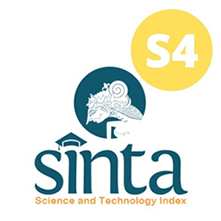Design and build analysis of the use of bioradar sensors for portable non-contact respiration monitoring
Abstract
Respiratory disorders are a critical health problem. Respiration is a vital activity for the proper functioning of the body. Pandemic SARS-CoV-2 virus is a highly contagious disease and causes rapid spread of droplets. This study aims to determine the effectiveness of the bioradar sensor used in non-contact respiration monitoring by exploring the distance to find out the optimal distance for sensor readings in monitoring respiration rate per minute. The results of this study for the 3 treatments given to respondents did not affect the results of measuring respiration rate. At distances of 10 cm and 25 cm they produce 40-43 times/minute, distances of 50 cm and 75 cm produce 33-36 times/minute, distances of 100 cm produce 20-22 times/minute and distances of 125 cm and 150 cm are not detected. The highest error value is -100.00% at a distance of 125cm and 150cm and the lowest error value is 3.39% at a distance of 100 cm. based on the results of the analysis of the effectiveness of sensor readings on distance, which is quite effective at a distance of ±100 cm. It is hoped that this research can reduce the level of disease transmission during the Covid-19 pandemic. The results of the study showed that the three treatments given to respondents did not affect the results of respiratory rate measurements. At a distance of 10 cm and 25 cm, it produced 40-43 times/minute, at a distance of 50 cm and 75 cm it produced 33-36 times/minute, at a distance of 100 cm it produced 20-22 times/minute, and at a distance of 125 cm and 150 cm it was not detected. The highest error value is -100.00% at a distance of 125 cm and 150 cm, and the lowest error value is 3.39% at a distance of 100 cm. Based on the analysis of the effectiveness of the sensor reading at a distance, it was found to be quite effective at a distance of ±100 cm. The implication of this study is that this bioradar sensor is effective in monitoring breathing rate at a distance of about 100 cm. The results of this study are expected to reduce the level of disease transmission during the Cov-19 pandemic, as non-contact monitoring can help in avoiding droplet spread, which is one of the ways the virus is transmitted. This study provides important information on the use of bioradar sensors in non-contact monitoring of breathing that can be used to improve the safety and quality of healthcare, especially in the context of a pandemic

This work is licensed under a Creative Commons Attribution-ShareAlike 4.0 International License.
Authors who publish with this journal agree to the following terms:
- Authors retain copyright and grant the journal right of first publication with the work simultaneously licensed under a Creative Commons Attribution License that allows others to share the work with an acknowledgement of the work's authorship and initial publication in this journal.
- Authors are able to enter into separate, additional contractual arrangements for the non-exclusive distribution of the journal's published version of the work (e.g., post it to an institutional repository or publish it in a book), with an acknowledgement of its initial publication in this journal.
- Authors are permitted and encouraged to post their work online (e.g., in institutional repositories or on their website) prior to and during the submission process, as it can lead to productive exchanges, as well as earlier and greater citation of published work (See The Effect of Open Access).











